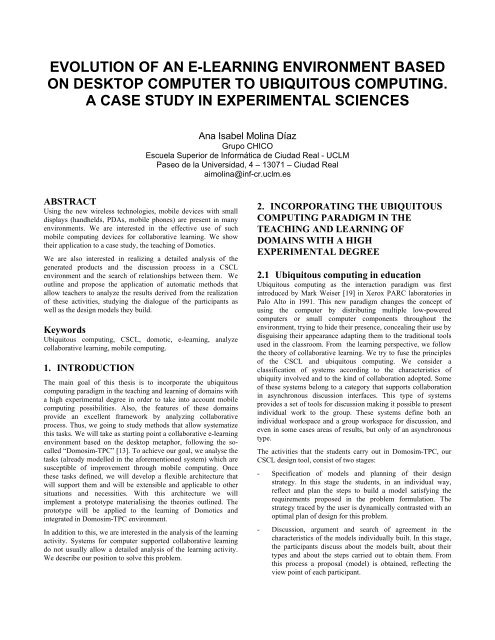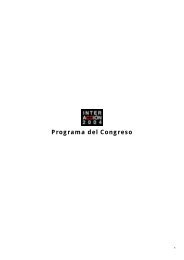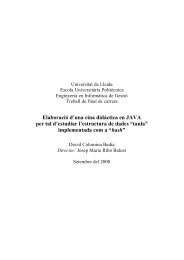Proceedings Template - WORD - GRIHO
Proceedings Template - WORD - GRIHO
Proceedings Template - WORD - GRIHO
Create successful ePaper yourself
Turn your PDF publications into a flip-book with our unique Google optimized e-Paper software.
EVOLUTION OF AN E-LEARNING ENVIRONMENT BASEDON DESKTOP COMPUTER TO UBIQUITOUS COMPUTING.A CASE STUDY IN EXPERIMENTAL SCIENCESAna Isabel Molina DíazGrupo CHICOEscuela Superior de Informática de Ciudad Real - UCLMPaseo de la Universidad, 4 – 13071 – Ciudad Realaimolina@inf-cr.uclm.esABSTRACTUsing the new wireless technologies, mobile devices with smalldisplays (handhelds, PDAs, mobile phones) are present in manyenvironments. We are interested in the effective use of suchmobile computing devices for collaborative learning. We showtheir application to a case study, the teaching of Domotics.We are also interested in realizing a detailed analysis of thegenerated products and the discussion process in a CSCLenvironment and the search of relationships between them. Weoutline and propose the application of automatic methods thatallow teachers to analyze the results derived from the realizationof these activities, studying the dialogue of the participants aswell as the design models they build.KeywordsUbiquitous computing, CSCL, domotic, e-learning, analyzecollaborative learning, mobile computing.1. INTRODUCTIONThe main goal of this thesis is to incorporate the ubiquitouscomputing paradigm in the teaching and learning of domains witha high experimental degree in order to take into account mobilecomputing possibilities. Also, the features of these domainsprovide an excellent framework by analyzing collaborativeprocess. Thus, we going to study methods that allow systematizethis tasks. We will take as starting point a collaborative e-learningenvironment based on the desktop metaphor, following the socalled“Domosim-TPC” [13]. To achieve our goal, we analyse thetasks (already modelled in the aforementioned system) which aresusceptible of improvement through mobile computing. Oncethese tasks defined, we will develop a flexible architecture thatwill support them and will be extensible and applicable to othersituations and necessities. With this architecture we willimplement a prototype materialising the theories outlined. Theprototype will be applied to the learning of Domotics andintegrated in Domosim-TPC environment.In addition to this, we are interested in the analysis of the learningactivity. Systems for computer supported collaborative learningdo not usually allow a detailed analysis of the learning activity.We describe our position to solve this problem.2. INCORPORATING THE UBIQUITOUSCOMPUTING PARADIGM IN THETEACHING AND LEARNING OFDOMAINS WITH A HIGHEXPERIMENTAL DEGREE2.1 Ubiquitous computing in educationUbiquitous computing as the interaction paradigm was firstintroduced by Mark Weiser [19] in Xerox PARC laboratories inPalo Alto in 1991. This new paradigm changes the concept ofusing the computer by distributing multiple low-poweredcomputers or small computer components throughout theenvironment, trying to hide their presence, concealing their use bydisguising their appearance adapting them to the traditional toolsused in the classroom. From the learning perspective, we followthe theory of collaborative learning. We try to fuse the principlesof the CSCL and ubiquitous computing. We consider aclassification of systems according to the characteristics ofubiquity involved and to the kind of collaboration adopted. Someof these systems belong to a category that supports collaborationin asynchronous discussion interfaces. This type of systemsprovides a set of tools for discussion making it possible to presentindividual work to the group. These systems define both anindividual workspace and a group workspace for discussion, andeven in some cases areas of results, but only of an asynchronoustype.The activities that the students carry out in Domosim-TPC, ourCSCL design tool, consist of two stages:- Specification of models and planning of their designstrategy. In this stage the students, in an individual way,reflect and plan the steps to build a model satisfying therequirements proposed in the problem formulation. Thestrategy traced by the user is dynamically contrasted with anoptimal plan of design for this problem.- Discussion, argument and search of agreement in thecharacteristics of the models individually built. In this stage,the participants discuss about the models built, about theirtypes and about the steps carried out to obtain them. Fromthis process a proposal (model) is obtained, reflecting theview point of each participant.
2.2 Domosim-TPCThe domain where our investigation is being applied is thelearning of the design of automated control facilities in buildingsand housing, also called Domotics. The term Domotics isassociated to the set of elements that, when installed,interconnected and automatically controlled at home, release theuser of the routine of intervening in everyday actions and, at thesame time, provide optimized control over comfort, energeticconsumption, security and communications. In this kind oftraining, the realization of practical experiments is speciallyimportant. In order to soften this problem by means of the use oftechnology, we have developed a distributed environment withsupport for distance learning of domotics design: DomoSim-TPC.In DomoSim-TPC the teacher carries out a presentation oftheoretical contents. Next, the students are organized in smallgroups whom the teacher assigns the resolution of designproblems. The students use an individual workspace to design themodels that they consider will satisfy the requirements of theproposed problems. Later on, they discuss, comment and justifythe design decisions taken, building a base of shared knowledge.2.3 Towards a Mobile DomosimOur purpose entails improving the traditional classroomenvironment with the collaborative and the ubiquitous computingparadigms (in particular, mobile computing). We intend toimplement a prototype in a particular environment forcollaborative learning (Domosim-TPC). We have to adapt theasynchronous tools of Domosim to the characteristics of mobiledevices. To do this, it is necessary to restructure the user interfaceto adapt it to the constraints of size and utility of this kind ofappliances.In order to sustain a learning activity, we identify the concept ofspace [14]. This is, a virtual structured place with resources andtools to perform a task (to solve a problem). There are threespaces:- An individual workspace to design models satisfying aspecification.- A shared space for discussion and argumentation about thedesign actions that the learners have planned. Thisworkspace provides support for issue-based conversation andrelates the dialogue contributions with the actions of designmodels.- Another shared space with the results of the discussionprocess. In this workspace the table of contents metaphor isused. This table contains and organizes design models inwhich the learners have reached agreement.If we want to generalize this process to the learning environmentof other disciplines, we can automate the transformation processof the user interface. For CSCL tools developers, this introducesthe problem of constructing multiple versions of applications fordifferent devices. There are many dimensions to consider whendesigning context-dependent applications (environments,platforms, domain, users,…). We intend to identify similar tasksin CSCL tools to automate obtaining mobile version of acollaborative design environment.There are several solutions to the problem of building deviceindependentuser interfaces. An interface model for separating theuser interface from the application logic and the presentationdevice is necessary. There are several markup languages that helpin this purpose (UIML [1], XML,…). This kind of languagesallows the production of device-independent presentations for arange of devices. But these solutions do not provide high-levelguidance guaranteeing quality across multiple versions ofapplications. We propose the use of a model-based design of GUI,which focuses on the tasks supported. The idea is that taskanalysis provides some structure for the description of tasks oractivities, thus making it easier to describe how activities fittogether, and to explore what the implications of this may be forthe design of user interfaces. A number of approaches to taskmodeling have been developed (GOMS [5], HTA [2], CTT [10,11],…). The logical decomposition of tasks is reflected in theselection, consistency and grouping of elements in the GUIobtained.We intend to identify common high-level task patterns in CSCLenvironments that allows the development of a complete semiautomaticenvironment that generates CSCL and mobile tools,independent of the study domain and the platform.We use graphical ConcurTaskTrees (CTT) notation [10, 11] foranalysing tasks in Domosim-TPC. Some important features aresupported in CTT: hierarchical logical structures, temporaryrelationships among tasks, and cooperative tasks modelling.Cooperative work combines communication, individual action,and collaboration. This notation aims to provide an abstractrepresentation of these aspects.3. APPLYING SEMI-AUTOMATICMETHODS TO ANALYZECOLLABORATIVE LEARNINGEXPERIENCES IN AN E-LEARNINGENVIRONMENTCurrently, most systems used for computer supportedcollaborative learning do not allow detailed analysis of theinteraction that takes place among the members of a group. Someauthors point out the importance of studying the interaction toobtain conclusions about the work carried out. Revising thebibliography we can observe systems using diverse techniquesand approaches to solve the problem (Hidden Models of Markov[18], finite states machines [8], fuzzy logic [3, 4 ,12],…)However, these projects only consider the dialogue, but they donot generally consider the domain aspects and tasks carried out.This way, considering the model of learning activities defined inDomoSim-TPC system, we outline and apply automatic methodsthat allow the teachers to analyse the results from these activities.These methods study the dialogue of the participants as well asthe design models they build.Our first objective is the organization of the great volume ofinformation registered in the system and related to: theelaboration of solutions, the discussion and argumentation of thesolutions, the characteristics of the generated products and theusers’ interaction with the system. This information will be usedto infer relative attitudes of the users and relative to the group. Inorder to carry out the analysis we select several factors to study.We synthesize them as follows:- The tasks of individual elaboration that will generatesolutions to the proposed problems.
- The collaboration originated in the discussion andargumentation process in which the students justify, questionand explain decisions taken while elaborating the solutions.- Some cognitive aspects related to the learning skill that thestudents achieve. We try to determine the relationshipbetween the student's knowledge and the way the studentsface up the resolution of new problems. For this, we contrastthe resolution structures that the student outlines withstructures proposed by experts.- The relationships observed among the elaboration process,the collaboration, the models built and the level ofknowledge or dexterity that the participants reach. Weoutlined a framework to carry out a deep study that allows usto determine what relations are observed among theaforementioned elements in a learning activity.Considering the aforementioned factors, we define our model ofactivities analysis. The information processed comes from data oftwo different origins: the organization of the activity and itsrealization. Regarding the organization of the activity we considersome general characteristics, the problem whose resolution isproposed and the optimal strategies that shape its solution. Eachproblem is structured in several tasks to solve. Each task can beassigned to one of the participants in the activity. Each task has adesign plan associated proposing the best strategy to solve it.These plans are used to contrast with the solutions built by thestudents. This way, we can automatically determine and evaluatethe differences among them.The previous information is processed in a quantitative study. Inthis study the information is organized and statistics reflecting anevaluation on particular aspects of the realization of the activity isgenerated. This study is complementary to another one of aqualitative kind in which rules and fuzzy logic are used to modelother characteristics. Thus, with the statistical informationgenerated previously and considering the observer's approacheswhile carrying out the analysis, conclusions relative to thelearning activity can be inferred. These conclusions are classifiedin those relative to the elaboration and discussion process, thoserelative to the solutions built and those relative to the skill levelthat the participants have reached. With these conclusions andwith all the information obtained previously, it would not bedifficult to find some relationships among them.We propose the use of a supervised learning algorithm (classifiergenetic algorithm [9]) to identify and predict effectivecollaborative learning episodes [16, 17]. The classifier systemswas invented by Holland [7] and it is a parallel productionsystem. In short we can say that a classifier system takes an input,coded as a message. This message then activates rules which canthen activate other rules or produce an output to the outsideworld. The algorithm used to evaluate the rules of the classifiersystem is called the bucket-brigade-algorithm [6, 15].The Pittapproach concentrates on optimisation of complete rule-setscoded as chromosomes and in this way the performance of thesystem is expected to improve. We define the descriptors(conditions in classifiers) shown in Table 1.Table 1. Descriptors and attributes for defining processes andproducts in a collaborative learning episodeATTRIBUTE KIND OF ATTRIBUTE VALORDESCRIPTORV Validity Product NV/VI/VR/VC/VGBNo Valid /Valid Incorrect/Valid Redundant/Valid Correct/Valid Good BuiltD? Difficulty Product Y/N Yes/NoM Modelling Process L/M/H Low/Medium/HighD Discussion Process L/M/H Low/Medium/HighC Cohesion Process L/M/H Low/Medium/High4. CONCLUSIONS AND FUTURE WORKSIn this paper we describe our purpose to improve the traditionalclassroom environment with the collaborative and the ubiquitouscomputing paradigms. At first sight, it is not necessary to carryout extraordinary changes in the class management. We willimplement a prototype in a particular environment forcollaborative learning (Domosim-TPC). This process revealsseveral problems related to the user interface design and develop.We intend to automate the generation of the mobile equivalentinterface for a desktop CSCL version.We are also interested in realizing a detailed analysis of thegenerated products and the search of relationships between theworking process and the generated results in a CSCLenvironment. We are researching on automatic methods thatallowed teachers to analyse the results derived from therealization of the activities (studying the dialogue of participantsas well as the design models they build).5. ACKNOWLEDGMENTSThis work has been partially supported by the Junta deComunidades de Castilla – La Mancha and the Ministerio deCiencia y Tecnología in the projects PBI-02-026 and TIC2002-01387.6. REFERENCES[1] Abrams, M., Phanourious, C., Batongbacal, A.L., Williams,S. & Shuster, J. UIML: An appliance-independent XML userinterface language. In A. Mendelson, editor, <strong>Proceedings</strong> of8 th International World-Wide Web Conference WWW’8(Toronto, May 11-14, 1999), Amsterdam, 1999. ElsevierScience Publishers. Accesible at http://www8.org/w8-papers/5b-hypertext-media/uiml/uiml.html.[2] Annett, J., Duncan, K.D., Task Analysis and TrainingDesign, Occupational Psychology, 41, pp. 211-221, 1967.[3] Barros, B. & Verdejo, M. F. (1999). DEGREE: Un sistemapara la realización y evaluación de experiencias deaprendizaje colaborativo en enseñanza a distancia. RevistaIberoamericana de Inteligencia Artificial (9), pp. 27-37.[4] Barros, B. (1999). Aprendizaje Colaborativo en Enseñanza aDistancia: Entorno Genérico para Configurar, Realizar yAnalizar Actividades en Grupo. Tesis Doctoral:Departamento de Inteligencia Artificial. UniversidadPolitécnica de Madrid.
[5] Card, S., Moran, T., Newell, A., The Psycology of Human-Computer Interaction, Lawrence Erlbaum, Hillsdale, 1983.[6] Goldberg D.E. Genetic Algorithms in Search, Optimization& Machine Learning. Addison Wesley Publishing Company,Inc., University of Alabama, 1989.[7] Holland, J.H., Genetic Algorithms and Classifier Systems:Foundations and Future Directions”. Genetic Algorithms andTheir Applications: <strong>Proceedings</strong> of the 2 nd InternationalConference on Genetic Algorithms, 1987.[8] McManus, M., & Aiken, R. (1995). Monitoring computerbasedproblem solving. Journal of Artificial Intelligence inEducation, 6(4), 307-336.[9] Molina, A.I., Redondo, M.A., Ortega, M. Un métodosemiautomático basado en algoritmos genéticos para elanálisis de experiencias de aprendizaje colaborativo. Talleren Sistemas Hipermedia Colaborativos y Adaptativos(JISBD’03). Alicante, Spain. Noviembre, 2003[10] Paternò, F., Mancini, C. & Meniconi. ConcurTaskTree: Adiagrammatic notation for specifying task models. In S.Howard, J. Hammond, and G. Lindgaard, editors,<strong>Proceedings</strong> of IFIP TC 13 International Conference onHuman-Computer Interaction Interact’97 (Sydney, July 14-18, 1997), pages 362-369, Boston, 1997. Kluwer AcademicPublishers.[11] Paternò, F., Santoro, C. & Tahmassebi, S. Formal model forcooperative tasks: Concepts and an application for en-routeair traffic control. In P. Markopoulos and P. Johnson, editors,Proc. of 5 th Int. Workshop on Design, Specification, andVerification of Intractive Systems DSV-IS ’98 (Abingdon,June 3-5 1998), pages 71-86, Vienna, 1998. Springer-Verlag.[12] Redondo, M.A., Bravo, C., Bravo, J., Ortega, M., (2003)Applying Fuzzy Logic to Analyze Collaborative LearningExperiences. Journal of the United States Distance LearningAssociation. Special issue on Evaluation Techniques andLearning Management Systems. Vol. 17, Nº 2, pp, 19-28.USA.[13] Redondo, M.A., Planificación Colaborativa del diseño enentornos de simulación para el aprendizaje a distancia.Doctoral Thesis. Departamento de Informática. Universidadde Castilla-La Mancha. 2002[14] Redondo, M.A., Molina, A.I., Bravo, C., Bravo, J. Ortega,M.Planificación Colaborativa y Ubicua para el aprendizaje deldiseño en el sistema Domosim-TPC. Proc. of VI CongresoIberoamericano de Informática Educativa. Vigo(Spain). 2002.[15] Riolo, R. CFS-C: A Package of Domain IndependentSubroutines for Implementing Classifier Systems inArbitrary, User Defined Environments. 1998.[16] Soller A., Goodman, B., Linton, F., & Gaimari, R. (1998).Promoting Effective Peer Interaction in an IntelligentCollaborative Learning System. <strong>Proceedings</strong> of the 4 thInternational Conference on Intelligent Tutoring Systems(ITS 98). San Antonio, TX, 186-195.[17] Soller A., Lesgold, A., Linton, F., & Goodman, B. (1999).What Makes Peer Interaction Effective? Modeling EffectiveCommunication in an Intelligent CSCL.[18] Soller A., Wiebe, J., & Lesgold, A. (2002). A MachineLearning Approach to Assessing Knowledge Sharing DuringCollaborative Learning Activities. <strong>Proceedings</strong> of ComputerSupport for Collaborative Learning’2002[19] Weiser, M. The future of Ubiquitous Computing on Campus,Comm. ACM 41-1, January 1998, 41-42 (1998)




